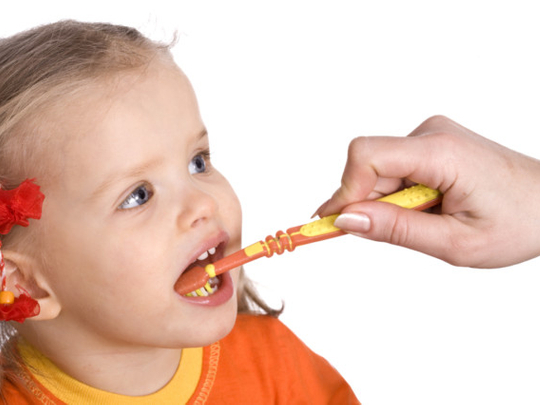
Setting up a good routine for dental hygiene early on should put children on the right path for caring for their teeth as they grow up, along with creating a healthy environment for their adult teeth to grow in to.
Milk or first teeth act as space-savers for adult teeth. If they are lost early through decay, adult teeth can drift, leading to a greater likelihood of corrective braces later.
Because milk teeth have a thinner covering of enamel than adult teeth, they decay more easily. According to a recent survey, more than 40 per cent of those under 5 have some form of tooth decay, with 12 per cent already having one filling or more.
Most babies get their first tooth at between 6 and 9 months, although it is not uncommon for this to be a few months earlier or later.
Birmingham-based NHS dentist Dr Janet Clarke, a spokesperson for the British Dental Association, advises parents to start cleaning as soon as the first tooth begins to cut through. Use a tiny spot of baby toothpaste on your little finger, rather than a brush.
At this stage it’s all about getting the child used to the idea and establishing a habit very early on, so that it becomes a part of the getting-up and going-to-bed routines, she says. As more teeth emerge, parents can graduate to a soft-headed baby toothbrush.
Make sure you choose an age-appropriate toothpaste — those for younger children will have milder flavours and contain the correct amount of fluoride.
Those under 3 need a minimum of 1,000 ppm (parts per million), as any less won’t be as effective at fighting decay.
Use a smear no bigger than your fingernail, so it’s not an issue if they swallow their toothpaste (ingesting too much can cause fluorosis, which appears as very fine, pearly white lines or flecking on the surface of the teeth).
Those over 3 can have a pea-sized blob containing 1,350 to 1,500 ppm fluoride.
Babies should no longer be using a bottle by the time they are 1, because the teats encourage them to suck for a long time, which can mean the drinks that cause decay can stay in contact with their teeth for a long time.
If they still have a drink of milk at bedtime at this age, Clarke advises brushing their teeth afterwards — not before — and never leaving the bottle in their cot.
Even milk has a form of sugar in it and at night our mouths produce less saliva, which cleans the teeth.
While the advice used to be to rinse after brushing, dental professionals now advocate the spit- don’t-rinse approach.
Two minutes of brushing twice a day is recommended, but Clarke points out that this is a long time for babies and toddlers, and that your main focus should be on systematically brushing all the surfaces of each tooth, rather than clocking up the minutes.
Where you can, make it a game. Don’t turn it into a battle. If they’re having a bad day, or if they are tired or unwell, then try again tomorrow. Missing the odd day isn’t the end of the world.
You should supervise your child’s tooth-brushing until they are about 7, by which time they should have the coordination to do it themselves, although it’s still worth checking up on their technique regularly.
Clarke emphasises that water and milk are the best drinks for children, rather than squashes and other sugary drinks and even fruit juice, which is high in the sugars and acids that cause tooth decay.
Sugary snacks, particularly chewy sweets that stick in the teeth, should be avoided where possible.
Clarke suggests taking your child to the dentist for the first time when they are a little over 2, by which point most will have their full set of 20 milk teeth.
Try to go every six to twelve months after that, as recommended by your dentist.
As the permanent teeth come in — most children lose their last milk tooth when they are about 12 — dental care will step up a gear. The first permanent teeth start to arrive when they are about 6.
Molars can be sealed with a plastic coating, known as fissure sealant, or painted with fluoride varnish to help prevent decay. Both are available on the NHS if suitable for your child.
Dentists may advise fluoride supplements for some children and can show you how to use floss, as this can be a very effective way of cleaning between teeth, particularly permanent teeth.
— Daily Mail












